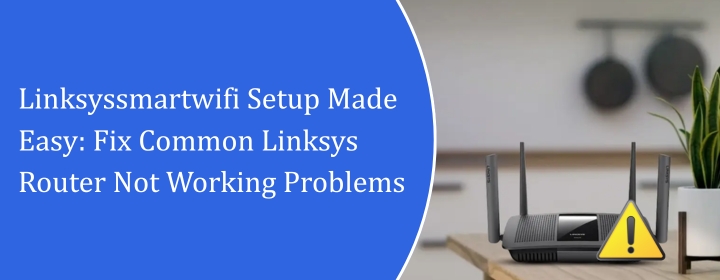
Linksyssmartwifi Setup Made Easy: Fix Common Linksys Router Not Working Problems
Installation of a Linksys router is not difficult, right? Insertion, hook up your appliances & that is all. And a person, who ever tried to establish a linksyssmartwifi setup, knows that it is not as simple as that always.
Sometimes devices refuse to connect regardless of the efforts involved due to old firmware issues or any other reason. There are plenty of things that may drive your network to work abnormally. This is a step by step guide explaining how to make your Wi-Fi work and troubleshooting when your linksys router not working.
Step 1: Place Router Appropriately
- In your home the main router will be located centrally. Not in a cupboard or behind solid pieces of furniture.
- Do not keep it close to microwaves, cordless phone, or any other electronics that disrupt Wi-Fi.
- When you are using a mesh arrangement ensure that some secondary units are not too distant, as to be weak signal, but they should be sufficiently distant to get a good coverage.
Step 2: Try LinksysSmartWiFi App Setup
- Open the application and sign T1-in with or without creating a Linksys account.
- If there are prompts that prompt you to add your router then follow those prompts.
- Give your network (SSID) and come up with a strong password. This is not to be skip on default credentials are insecure and public.
Step 3: Troubleshooting: When my Linksys router not working
Things may go wrong even after following the set up. This is a list of the actual problems that may occur to people and the way of rectifying them.
- Router will not start: Test to be sure that the power adapter is on and functioning. Test a different outlet.
- There is no internet: H ensure that there is connection between the router and the modem. Restart both devices. In some occasions, the reconnecting of a new router requires the modem to be restarted.
- Software is not working: Check that you are using the right Wi-Fi password. Clear your network cache either your phone or laptop.
- Low speeds: Lag can be created by interference, positioning, or old firmware. Test speed near router and near far nodes in order to examine whether the coverage is biased.
Step 4: Software updates and advanced settings
The process of updating firmware is one of the neglected stages in the process of linksyssmartwifi setup.
- Opening the Linksys app OR logging in through the Web browser.
- The updates would be detect under the Router Settings or Administration tab.
- Install updates and restart of the router.
Step 5: Reset and Repeat
- Hold the reset button of the router on the back side at the time of 10 seconds.
- Allow the lights to stabilize.
- Re-install the linksys smart wifi setup with the app.
Step 6: Optimize the Coverage by Testing
After installation and firmware installation:
- Test signal strength of devices in your home by walking around the house.
- Move nodes if needed. A minor change can enhance the speed in dead zones.
- Try out various equipment to ensure the Wi-Fi is not faulty.
It will help avoid frustration later on and will make sure that your linksyssmartwifi configuration is functioning as expected.
Step 7: Real-world Troubleshooting Linksyssmartwifi Setup Tips
About the proper setup, some unexpected issues occur. The following is what most of the time works:
- You should recall that you should power cycle your router once a week in case it experiences intermittent drops.
- Transparent network cache on devices, which are inaccessible.
- Record version of firmware and update.
- Always leave settings alone unless there is a reason to alter the advanced settings.
Step 8: Best practices and security
When the app has an automatic updates and notifications, turn them on. Installing the Linksyssmartwifi setup correctly ensures both speed and security.
Final thoughts
Configuring a linksys smart Wi-Fi is not as simple as plugging in a router, its placement & monitoring also has a huge role. The issues such as the linksys router not working are not uncommon but they can be resolve having the patience and the ability to troubleshoot the error step by step.
It takes a good setup to realize good coverage, reduced drops and the assurance that whatever you are doing on your network is behind closed doors.

